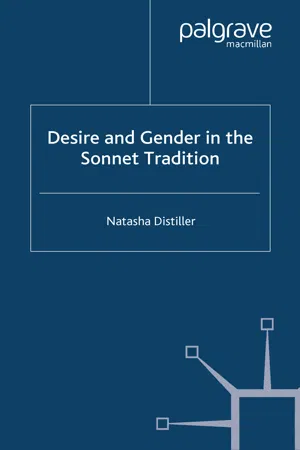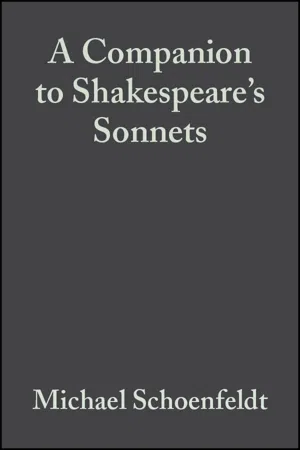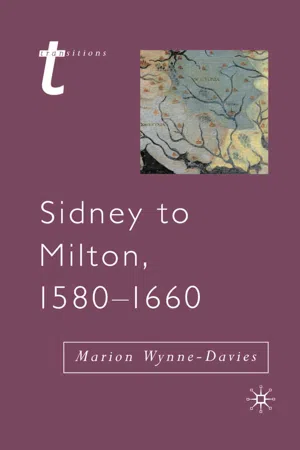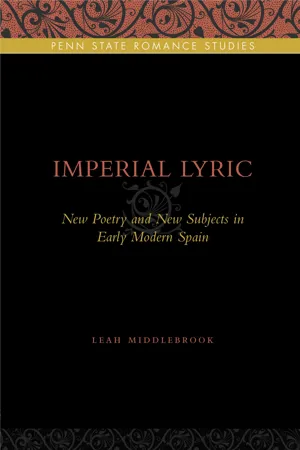Literature
Petrarchan Sonnet
A Petrarchan sonnet is a 14-line poem with a specific rhyme scheme and structure. It is divided into an octave (eight lines) and a sestet (six lines), with a volta, or thematic shift, occurring between the two sections. The rhyme scheme typically follows the pattern ABBAABBA for the octave and either CDCDCD or CDECDE for the sestet.
Written by Perlego with AI-assistance
Related key terms
1 of 5
9 Key excerpts on "Petrarchan Sonnet"
- eBook - PDF
- Nigel McLoughlin(Author)
- 2017(Publication Date)
- Red Globe Press(Publisher)
As it developed, there emerged unrhymed sonnets; tailed sonnets (15–20 lines); such as those by Milton, and curtal (or curtailed) sonnets (10–13 lines); perhaps most famously by Gerard Manley Hopkins. The various sonnet types have been put to good use by every major movement within poetry, from Donne and other metaphysical poets through to the eras of the Romantics and the Victorians. A strong sonnet tradition persists today, and poets continue to innovate, as can be seen, for example, in the work of Geraldine Monk, Keith Jebb and Robert Sheppard; however, poets such as Rose Kelleher and Seamus Heaney have also continued to use the form in more classic mode. Varieties of the Sonnet 3 How does a Petrarchan Sonnet work? The Petrarchan variety of the sonnet generally consists of 14 lines, which are usually split into an octave (8 lines) and a sestet (6 lines), though the actual poem may appear as a 14-line unit. There will usually be a volta , or a classic turn, and this will usually be found between the octave and sestet, though there may be some variation in its exact position. Classically, the Petrarchan Sonnet is metrically regular (usually in iambic pentameter) with a formal rhyme scheme, though these constraints are more honoured in the breach than the observance these days. On His Being Arrived to the Age of Twenty-Three How soon hath Time , the subt le thief of youth , A Sto len on his wing my three and twen tieth year! B My hast ing days fly on with full car eer , B But my late spring no bud or blossom shew’th. A Perhaps my semblance might deceive the truth, A That I to manhood am arrived so near, B And inward ripeness doth much less appear, B That some more timely-happy spirits indu’th. A Yet be it less or more, or soon or slow, C It shall be still in strictest measure even D To that same lot, however mean or high, E Toward which Time leads me, and the will of Heaven, D All is, if I have grace to use it so, C As ever in my great Task-master’s eye. - eBook - ePub
The early modern English sonnet
Ever in motion
- Laetitia Sansonetti, Rémi Vuillemin, Enrica Zanin, Laetitia Sansonetti, Rémi Vuillemin, Enrica Zanin(Authors)
- 2020(Publication Date)
- Manchester University Press(Publisher)
24 Even if they are not explicitly justified, the innovations proposed in mid-Cinquecento poetic practice looked for a way to affirm the potential of the sonnet form and to free it from the sometimes oppressive examples of the literary tradition.The sonnet and modernityBembo’s and Trissino’s treatises, and the several poetic anthologies published in the central years of the century, may be considered as the poetic background to Antonio Minturno’s Arte poetica, first published in 1563.25 In the conventional shape of a dialogue, Minturno proposes his summa on the different types of poetic forms of Italian literature. The sonnet is discussed in book III, within a fictive dialogue between the poet Bernardino Rota and Minturno himself. The definition given through Rota’s questions and Minturno’s answers is clear: a sonnet is ‘a grave and elegant composition made of words, with a harmonious pattern of rhymes, and a measure of syllables interlaced following a certain number of lines, defined by a certain order’. A sonnet shall not be confused with the epigram:the epigram is a part of epic poetry, and the sonnet a part of melic poetry, as is shown by the name itself. As from the sound [suono] we have the sonnet [sonetto], from the act of singing [canto] we have the odes [canzone]: actually the sound and the act of singing are the same thing. The one who invented this name just wanted to indicate a short and harmonious song. Even if the term is a diminutive, it does not denote a humble style – on the contrary, it implies harmony and prettiness, without which especially this composition is worth nothing. […] In the epigram, one does not search for prettiness or harmony, but a sharp repartee or a sentence; in the sonnet, using selected words, elegantly and harmoniously interlaced and ordered, the reader seeks sometimes a grave feeling, sometimes a sharp one, sometimes a pleasant one. In the epigram, the number of lines is not predetermined, even if, when you have more than two or four verses, one should speak about elegy. In the sonnet the confines are predetermined, and they must not be crossed; moreover, even if the subject of it can be reduced in few lines, it is not similar to the subject of the stanzas of an ode.26 - No longer available |Learn more
- Sonja Fielitz(Author)
- 2012(Publication Date)
- Universitätsverlag Winter(Publisher)
Shaping the Sonnet Italian Style: Petrarch, Tasso, Daniel and Shakespeare Roy T. Eriksen (Kristiansand, Norway) How does Shakespeare’s practice of the sonnet form relate to that of his Italian predecessors? This is admittedly a large question, and I hasten to explain that I will limit my discussion to a few instances of what could be termed holistic patterning typical of the Italian sonnet and its implications. One formal feature of particular interest in this context is the continued use of the volta or the division of the sonnet into eight plus six verses, regardless of the main division of a Shakespearean sonnet into three quatrains and a couplet. My approach therefore entails an alternative way of considering the structural and elocutionary patterning of Renaissance sonnets and their poetic and ethical underpinnings. I aim to describe and trace formal features characterizing and shaping the sonnet from its invention in the early thirteenth century. This will, I propose, bear on how we interpret the mini-genre and its place within the context of contemporary culture. Rather than considering the sonnet as a 14-line poem with one or more standardised rhyme-schemes, sonnet form is here approached as a well-defined textual field and a spatial construct subservient to rules that arguably can be termed architectural. 1 Shakespeare’s Sonnet 55 is well-suited to illustrate my concerns in this article as it compares and contrasts architectural structures to the kind of “rooms” created in poetry: Not marble nor the gilded monuments Of princes shall outlive this powerful rhyme, But you shall shine more bright in these contents Than unswept stone, besmeared with sluttish time. (1-4) 2 In addition to contrasting time with eternity and aligning monuments to poems in the Ovidian and Horatian idiom of the monumentum aere perenne , the first quatrain also draws attention to the use of lights or verbal ornament in the poem (the beloved “shall shine more bright”). - eBook - PDF
- Peter Hyland(Author)
- 2017(Publication Date)
- Red Globe Press(Publisher)
The form appears to have originated in southern Italy a century or so before Petrarch wrote, but he made it so fashionable that it was exported to Spain in the fifteenth century, to France and England in the sixteenth, and to Germany in the seventeenth. 1 The Italian sonnet was a fourteen-line poem with eleven syllables to a line, and as Petrarch developed it, it fell into two parts, an eight-line section (now called an ‘octave’) with the rhyme-scheme abbaabba , and a six-line section (the ‘sestet’) cdecde , though there were variants of this ( cdcdcd , cdedce , cdeced ). Whatever the variant within the sestet, Italian sonnets avoided ending with a couplet. I shall return to a considera-tion of the implications of these rhyme-schemes later. A sonnet that exhibits clearly many of the devices developed by Petrarch is number 132 of the Canzoniere : S’amor non è, che dunque è quel ch’io sento? a ma s’egli è amor, per Dio, che cosa e quale? b se bona, ond’è l’effetto aspro e mortale? b se ria, ond’è sì dolce ogni tormento? a S’a mia voglia ardo, ond’è ‘l pianto e lamento? a s’a mal miogrado, il lamentar che vale? b O viva morte, o dilettoso male, b Shakespeare and the Elizabethan Sonnet 127 come puoi tanto in me, s’io no ‘l consento? a E s’io ‘l consento, a gran torto mi doglio. c Fra sì contrari vènti in frale barca d mi trovo in alto mar, senza governo, e sì lieve di saver, d’error sì carca, d ch’i’ medesmo non so quel ch’io mi voglio, c e tremo a mezza state, ardendo il verno. e A modern translation of this sonnet (without attempting a replication of the rhyme-scheme) renders it as follows: If it’s not love, then what is it I feel? But if it’s love, by God, what is this thing? If good, why then the bitter mortal sting? If bad, then why is every torment sweet? If I burn willingly, why weep and grieve? And if against my will, what good lamenting? O living death, O pleasurable harm, how can you rule me if I not consent? And if I do consent, it’s wrong to grieve. - eBook - PDF
- N. Distiller(Author)
- 2008(Publication Date)
- Palgrave Macmillan(Publisher)
It will begin with a brief overview of Petrarchism. Petrarchism in England: an overview Because Petrarch himself was synthesising a complex range of tra- ditions, which also had their ongoing English incarnations, it is notoriously difficult to quantify his influence on the poetry of the first English sonneteers (Ferry 1983: 15–16). By the end of the sixteenth century, most of the hundreds, if not thousands, of English Petrarchan Sonneteers would not have read Petrarch. They would have approached the tradition he inaugurated either through their own poets, or through the writing of the French Pléiade, Ronsard, DuBellay, and Desportes. 1 English Petrarchism, then, is not coterminous with the works of Petrarch, although it is heavily indebted to them. Equally the term ‘sonnet’ to denote a fixed poetic form was still developing its current meaning of a lyric of 14 lines with a specific rhyme scheme and meter, and the notion of a ‘sonnet sequence’ is a nineteenth-century invention (the phrase was coined by Dante Gabriel Rossetti, and used to describe the poems in his House of Life [1870/ 1881]). The critical apparatus through which we have formulated these conventions is itself both historically and ideologically contingent upon the nineteenth century, and performs important cultural work in the construction of Petrarchism as a literary discourse (Warley 2005: 23; Holmes 1999). Although the current categorisations are more modern than the poetry, the early modern sonnet sequence remains dominant as a poetic exemplum in the literary canons later generations invented. Petrarch has long been seen as a writer whose works inaugurated a subjectivity that can be understood as modern (Mazzotta 1993: 58–101; Freccero 1975: 37–8, 40). His sonnets play no small role in the discursive mapping of a type of subjectivity that will be familiar, if not commonsensical, to most modern readers. - eBook - PDF
- Michael Schoenfeldt(Author)
- 2008(Publication Date)
- Wiley-Blackwell(Publisher)
Followers of Petrarch wrote to be judged on their success in introducing variations within a narrow and prescribed space, using set vocabulary and subject matter. To be appreciated, the sonneteer presupposed an audience whose presuppositions he could rely on. An audience for a sonnet had to be able to recognize a new surprise in a convention of long established paradoxes. Perhaps the poems most typical of all the rhetorical actions of courtly love writers are those which exploit the apparently inexhaustible surprise of returning the language of religion to religious subject matter inside the courtly love and sonnet conventions. Dante did it in the thirteenth century; Donne did it in the seventeenth. A good example is this sonnet which George Herbert sent home to his mother from Cambridge: My God, where is that ancient heat towards thee, Wherewith whole showls of Martyrs once did burn, Besides their other flames? Doth Poetry Wear Venus Livery? only serve her turn? Why are not Sonnets made of thee? and layes Upon thine Altar burnt? Cannot thy love Heighten a spirit to sound out thy praise As well as any she? Cannot thy Dove Out-strip their Cupid easily in flight? - eBook - ePub
- Marion Wynne-Davies, Julian Wolfreys(Authors)
- 2017(Publication Date)
- Bloomsbury Academic(Publisher)
Diane (1573). The French original follows Petrarchan convention carefully and was a popular verse, having been translated into English by Thomas Lodge in 1589. While Lodge’s poem offers a close rendition of Desportes’ text however, Ralegh’s version gives us a much freer interpretation,Like to a hermit poor in place obscureI mean to spend my days of endless doubt,To wail such woes as time cannot recure,Where none but Love shall ever find me out. My food shall be of care and sorrow made;My drink nought else but tears fallen from mine eyes;And for my light in such obscured shadeThe flames shall serve which from my heart arise. A gown of grey my body shall attire,My staff of broken hope whereon I’ll stay,Of late repentance linked with long desireThe couch is framed whereon my limbs I’ll lay: And at my gate Despair shall linger still,To let in Death when Love and Fortune will.(Brooks-Davies 1992, 142)Thematically the poem engages with the traditional Petrarchan concerns of love and power, in which the poet’s lady is able to represent both a personal love and the authority of the Queen. Its rhyme scheme follows the conventional pattern of ababcdcdefefgg, dividing the poem into the three quatrains and final couplet of the English sonnet form developed by Surrey. Like the Tudor sonneteers’, Ralegh’s translation is not intended to follow the original slavishly and this is particularly apparent when compared to the two earlier versions offered by Desportes and Lodge. The French original reads,Et tousjours, pour prier, devant mes yeux j’aurayLa peinture d’Amour et celle de ma dame, which Lodge translates as, and daylie when I pray,My mistris picture plac’t by loveShall witness what I say.(Latham 1951, 106–8)Both extracts imagine praying before the double image of the God of Love and the lover’s lady. Ralegh, on the other hand, ends his poem by admitting both death and despair into the poem at a predicted future time when his love will be rejected. The dialectic created by this inclusion opens the sonnet up to Greenblatt’s notion of self-fashioning, while also creating a link to a more widespread Petrarchan convention. - eBook - PDF
Shakespeare's Artists
The Painters, Sculptors, Poets and Musicians in his Plays and Poems
- B. J. Sokol(Author)
- 2018(Publication Date)
- The Arden Shakespeare(Publisher)
The typical use of such confounding structures SHAKESPEARE’S ARTISTS 126 is among the reasons why seeking straightforward dramatic or autobiographical contents in a sonnet sequence is likely to be misleading. Moreover, sonneteering traditions or conventions were often deliberately varied or played upon by sonneteers rather than followed, and by Shakespeare not least. Even the range of ways in which convention confronted originality is also hard to determine given that an estimated 300,000 sonnets were written in sixteenth-century Europe. 20 I intend here to look at the ways in which some famous and influential sonneteers play upon the long-established sonneteering modes of ‘eternizing’, Platonizing, and ‘naughting’, and to consider the ways in which Shakespeare treats similar modes in his sonnets. As numerous ambiguities and ironies characterize his treatments, we may extend by analogy Inga-Stina Ewbank’s remark that Shakespeare’s language in his sonnets ‘is not merely equal to [his] vocabulary’, 21 and say the same for his use of the traditional ‘language’ of sonneteering modes. Despite conventions of modesty, often the speakers in Renaissance sonnets who present themselves as artists are boastful, even aggressively so. For instance, Michelangelo’s Sonnet 92, addressed to Vittoria Colonna, claims ‘A thousand years, and more, after we leave, / They will see how most beautiful you were / And in loving you I was most right’. 22 More brutally, Ronsard’s ‘Quand vous serez bien vieille’ envisions a future when, remorsefully murmuring the name of her rejected lover, the beloved will sing the songs of the famous ‘Ronsard [who] praised me in the days when I was beautiful’. 23 This poem is relatively tender when compared with Sonnet 8 in Michael Drayton’s Idea , in which a poet-narrator imagines a fantasy future in which his rejecting beloved, grown ugly with age, will painfully read his lines describing her former beauty. - eBook - PDF
Imperial Lyric
New Poetry and New Subjects in Early Modern Spain
- Leah Middlebrook(Author)
- 2009(Publication Date)
- Penn State University Press(Publisher)
d 1 the kind of poetry we categorize as lyric was only just becoming established as a genre during the early modern period. Despite the preva- lence of Petrarchism as a compositional praxis, canzone, sonnets, and the other poetic forms that Spanish, French, and English poets adopted from Italy were viewed by many writers as poemi piccoli—poetry that was “small” both in length and in scope. It was often taken as poetry dedicated to the representation of trivial and frivolous themes instead of the great matters contained in epic and tragedy. 1 In this chapter I argue that the lyric rose to privilege within the context of the transformation of ideas about men as Spanish society shifted from a military to a courtierized culture—from a culture that celebrated its aristocratic warrior-heroes to one in which the agency and the physical prowess of the nobleman were suppressed, curtailed, and deflected into the courtliness associated with Italian sprezzatura. That is, I will be arguing for a reciprocal, mutually conditioning relationship between new ideals for poetry and for men in the early modern era. Moreover, I will speak for the essential modernity of this new poetry whose function was not to inscribe the present order within a continuum of culture (the function of ballad) or to recount Castilian greatness (the function of epic), but rather to rehearse and elaborate the image of the courtier as the new masculine ideal. One of the Spanish writers whose work supports these claims most clearly is Hernando de Acuña (1514–1580). Born into a noble family in Valladolid, Hernando de Acuña understood courtierization. The younger brother of one celebrated fighter (Pedro de Acuña) and the precocious favor- ite of another (Antonio de Leiva, the Marquis of Vasto; after the marquis’s death Acuña remained on close terms with his son), he also knew of the sonnetization: acuña, boscán, castillejo, and the politics of form 1 1.
Index pages curate the most relevant extracts from our library of academic textbooks. They’ve been created using an in-house natural language model (NLM), each adding context and meaning to key research topics.








